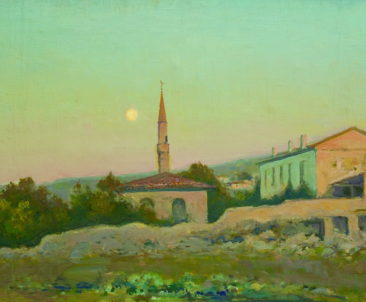

Alexander Kuprin – Russian and Soviet landscape painter, Honored Artist of the RSFSR, corresponding member of the USSR Academy of Arts.
Alexander Vasilievich was born in Borisoglebsk. His father was a teacher at the county school. When the boy was 13 years old, they moved to Voronezh, where Kuprin studied at the gymnasium and worked as a clerk on the railway. Alexander was always fond of art, which led him to the evening classes of the Society of Art Lovers. Later, having decided to become an artist, he left for St. Petersburg in 1902 and entered the AE Dmitriev-Kavkazsky school, but in 1904 left it, moved to Moscow and entered the KF Yuon studio. After studying there for two years, Kuprin transferred to the Moscow School of Painting, Sculpture and Architecture.
In 1908, the artist first saw in private collections of Moscow patrons new French painting, which became very interesting to Kuprin. The artist began to write and exhibit works in the spirit of this art. In 1909, he participated in the salon “Golden Fleece” with its collections, which were created during the time of life in Moscow under the influence of the latest trends in French art. Having learned a lot, the master left the school and devoted a large number of years to experiments in the field of artistic art. Kuprin was one of the active members of the “Jack of Diamonds” association. In the period 1910-1924, he preferred writing still lifes, starting with cubist works, gradually softening the geometric shape.
In 1920, the artist went to Nizhny Novgorod, where he worked as the head of the Nizhny Novgorod and Sormovsky art workshops. The year of return to Moscow (1924) turned out to be a turning point for the art of Alexander Vasilyevich, he turned to a realistic landscape, and also made annual trips to Bakhchisarai, where he wrote his first significant realistic paintings.
In the years 1930-1934 a new period began in the art of Kuprin. The artist worked on the industrial landscape, depicting factories in Dnepropetrovsk and Moscow, as well as oil fields in Baku. During these years, he again began to put the Crimea on canvas, and before the start of the war – the motives of Russian nature. Such landscapes again captured the attention of the artist, but in his last works he returned to industrial themes.
The painter survived, checked with his own hands, experienced almost all the artistic hobbies and manners, which in the years of his youth embarrassed the souls of young artists. He was led to realism by the complex process of adding a new person and a new artist.
It would be wrong to say that Kuprin in his youth and Kuprin at the time of creative maturity are two completely different artists. In his work a certain system of interests can be traced, which were characteristic of both the early and “most adult” period of art – attention to the emotional expressiveness of color, striving for strict constructiveness of the drawing, keen interest in the rhythmic mood of the composition, in which the pattern of the structure of objects and landscape is revealed. etc.
Creativity Alexander V. Kuprin peculiar great intellectual power. He was in love with the living beauty of nature and was inspired by the desire to check his impressions with his mind. In his works of art the light of creative, informative penetration in the imaged world glows.
Alexander Kuprin died in 1960 in Moscow. He was buried at the Novodevichy cemetery.